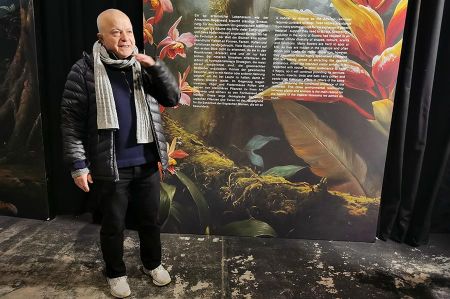Amazonia by Yadegar Asisi – Fascination of tropical rainforest
- Written by Portal Editor
Shortly before the official opening of the large panorama in the Dresden Panometer, we were also invited guests of the photographer, painter and architect Yadegar Asisi, who was born and raised in Vienna in 1955, then studied architecture in Dresden and painting at the University of the Arts in Berlin.
Since 2003, Asisi has been creating monumental 360° panoramas with a size of up to 3,400 square meters, mainly in old gasometers that have corresponding eaves heights of 30 or more meters.
360° panoramas of various locations
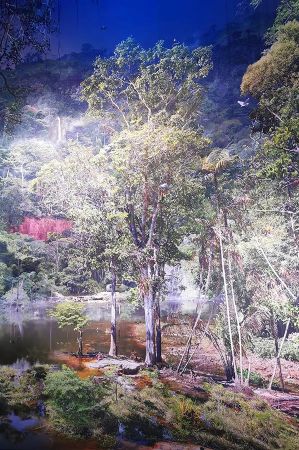 Amazonia was already shown in Leipzig in 2009, in Rouen in 2015 and in Hanover in 2017, as well as large panoramas of the ancient city of Pergamon, Dresden in the Baroque period and “The Wall – Life with the Death Strip” in Berlin. Amazonia is an absolutely worth seeing presentation of the tropical rainforest in the Dresden Panometer, especially since Yadegar Asisi himself shows great interest in nature's immeasurable biodiversity and its perfection, as he demonstrates at the beginning of his introduction. On their first joint exploration trip with the botanist Wilfried Morawitz in Brazil, the two encountered such massive complexity of the rainforest with its interlocking mechanisms that both were as fascinated as previous researchers.
Amazonia was already shown in Leipzig in 2009, in Rouen in 2015 and in Hanover in 2017, as well as large panoramas of the ancient city of Pergamon, Dresden in the Baroque period and “The Wall – Life with the Death Strip” in Berlin. Amazonia is an absolutely worth seeing presentation of the tropical rainforest in the Dresden Panometer, especially since Yadegar Asisi himself shows great interest in nature's immeasurable biodiversity and its perfection, as he demonstrates at the beginning of his introduction. On their first joint exploration trip with the botanist Wilfried Morawitz in Brazil, the two encountered such massive complexity of the rainforest with its interlocking mechanisms that both were as fascinated as previous researchers.
The natural panorama of the Amazon can therefore also be seen as a homage to all the naturalists who have explored the rainforest: First and foremost, Alexander von Humboldt, who travelled to the Amazon region at the beginning of the 19th century. So, it's no wonder that Yadegar Asisi began our meeting in the Panometer with Humboldt's portrait.
Dr. George McGavin – Doctor of Entomology at Imperial College
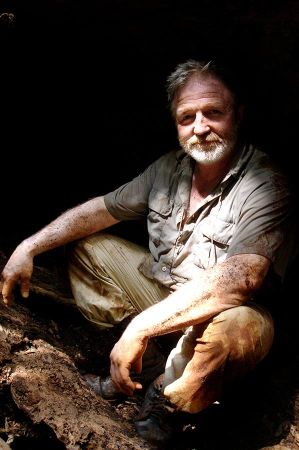 Our thoughts immediately went to another researcher named Dr. George McGavin, who we had met many years ago at the University of Oxford, where he was deputy curator of the museum's entomological collections from 1984 to 2008.
Our thoughts immediately went to another researcher named Dr. George McGavin, who we had met many years ago at the University of Oxford, where he was deputy curator of the museum's entomological collections from 1984 to 2008.
Never before had we seen such an extensive collection of insects and their function and importance in biodiversity, which were explained to us in detail and personally during our numerous visits. George was also a lecturer at Trinity College and then at Jesus College.
After a 30-year academic career, he then became a television presenter, working mainly for productions at the BBC Natural History Unit in Bristol. But more on that later.
Press conference in the Dresden Panometer
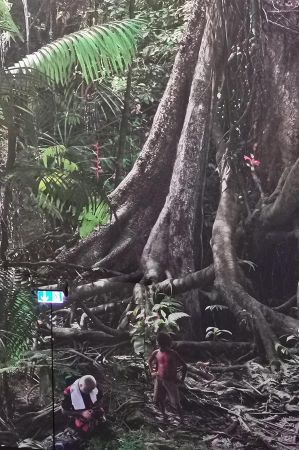 After his brief introduction to the biodiversity of the Brazilian jungle, especially insects and their importance, as well as the importance of slash-and-burn agriculture and deforestation of the rainforest and its impact on the global climate, we quickly went back to the current exhibition to prepare it Yadegar Asisi travelled to the Amazon region a total of four times.
After his brief introduction to the biodiversity of the Brazilian jungle, especially insects and their importance, as well as the importance of slash-and-burn agriculture and deforestation of the rainforest and its impact on the global climate, we quickly went back to the current exhibition to prepare it Yadegar Asisi travelled to the Amazon region a total of four times.
He took tens of thousands of photographs and countless sketches, watercolours and drawings, which he used for the 360° panorama.
In the tropical rainforest, plants grow both extremely close together and in a specific vertical order, which is known as stratification or storey structure.
Easy to follow in the large panorama, as the visitor tower alone gives the impression of different viewing positions in height.
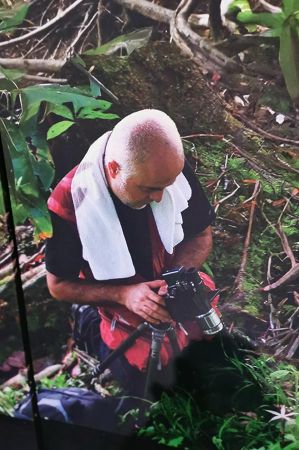 Four to six different floors are often described, although these cannot always be strictly separated from each other, but rather merge into one another; The characteristics of the different floors also depend on the location of the forest.
Four to six different floors are often described, although these cannot always be strictly separated from each other, but rather merge into one another; The characteristics of the different floors also depend on the location of the forest.
- the soil layer, consisting of the roots of the plants and a usually very thin layer of humus
- the herb layer, which can include, for example, mosses, ferns and other ground cover plants that require very little light
- the shrub layer up to a height of approx. 5 m, which also includes young trees
- the layer of low trees
- the crown layer with its main canopy at a height of approx. 40 m
- the so-called jungle giants known as “tree giants” which occasionally protrude up to a height of approx. 60 m above the main canopy
- Flat, wide-spreading root system made of powerful buttress roots in the Brazilian rainforest
The epiphytes use the stronger light in the upper regions
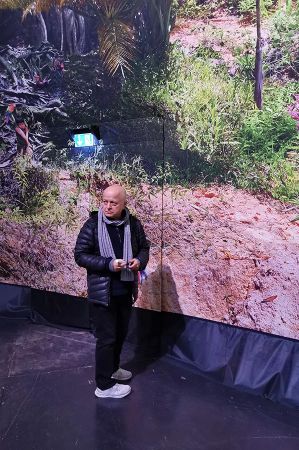 The trees usually have flat, wide-spreading roots that are either board or stilt roots. Common climbing plants in the rainforest are lianas and strangler figs. Epiphytes (flower-bearing perennial plants, such as bromeliads) and epiphylls (ferns, mosses and lichens) often grow on trees. They grow on forks and branches of trees, but do not form a physiological connection with the supporting tree.
The trees usually have flat, wide-spreading roots that are either board or stilt roots. Common climbing plants in the rainforest are lianas and strangler figs. Epiphytes (flower-bearing perennial plants, such as bromeliads) and epiphylls (ferns, mosses and lichens) often grow on trees. They grow on forks and branches of trees, but do not form a physiological connection with the supporting tree.
The epiphytes use the stronger light in the upper regions of the trees. Since there is a lack of water and nutrients at altitude, they use so-called niche leaves to form cavities in which humus is created and water is collected. Many bromeliads use their leaves to form cisterns in which water collects. This water is absorbed via the leaf surface with the help of special absorption organs (suction scales).
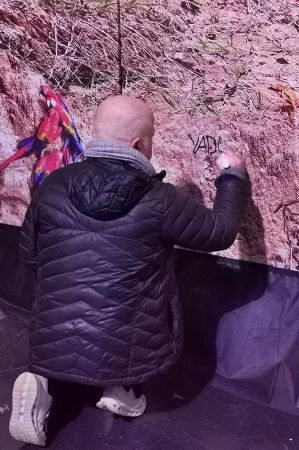 Epiphytic orchids, on the other hand, have aerial roots that are covered with an absorbent tissue. Lianas, on the other hand, have roots in the ground and only develop their leaves in the canopy. They are also able to develop aerial roots to ensure an additional water supply. Hemi-epiphytes have found a middle way for nutrient supply: They begin their life as an epiphyte (supply via the leaves) and, when there are supply shortages, form connections with the soil in order to obtain water and nutrients.
Epiphytic orchids, on the other hand, have aerial roots that are covered with an absorbent tissue. Lianas, on the other hand, have roots in the ground and only develop their leaves in the canopy. They are also able to develop aerial roots to ensure an additional water supply. Hemi-epiphytes have found a middle way for nutrient supply: They begin their life as an epiphyte (supply via the leaves) and, when there are supply shortages, form connections with the soil in order to obtain water and nutrients.
The fauna of the tropical rainforests is also characterized by an extraordinarily high level of biodiversity. By far the largest proportion is made up of arthropods - i.e. insects, arachnids, millipedes and crustaceans. Over time, natural selection led to an ever-better adaptation of the fauna to the ecological conditions of the rainforest. For example, the strikingly coloured tree climbing frogs of Central and South America spend their entire lives in the treetops - their spawn develops in the puddles of bromeliad leaves. Like many other rainforest amphibians, they are very poisonous.
Rainforest birds have strikingly colourful plumage
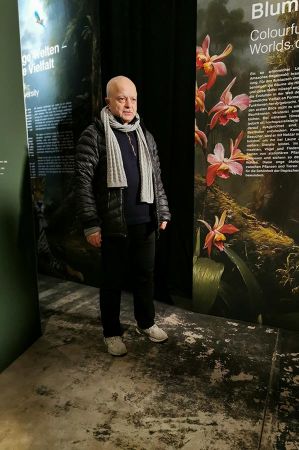 Some rainforest reptiles reach considerable size. Several species of crocodile and the South American anacondas should be mentioned here. Slightly smaller reptiles come from the group of turtles and chameleons. The birds of the rainforest often have strikingly colourful plumage, such as the parrots of all rainforests and hummingbirds (South America) and the birds of paradise (New Guinea and Australia). Mammals represent only a small group of species, the largest of which is the African forest elephant. The largest predator in Asia is the tiger and in South and Central America the jaguar. Primates are also found in most large rainforests: the orangutan, which lives in the rainforests of Southeast Asia, has become rare; Gorillas, chimpanzees and bonobos occur in Africa, and many species of dog monkeys live in rainforests there and in Asia; finally, the lemurs in Madagascar and many medium and small New World monkey species in the American rainforests. The rivers of the rainforests are very rich in fish. They feed river dolphins and giant otters in South America.
Some rainforest reptiles reach considerable size. Several species of crocodile and the South American anacondas should be mentioned here. Slightly smaller reptiles come from the group of turtles and chameleons. The birds of the rainforest often have strikingly colourful plumage, such as the parrots of all rainforests and hummingbirds (South America) and the birds of paradise (New Guinea and Australia). Mammals represent only a small group of species, the largest of which is the African forest elephant. The largest predator in Asia is the tiger and in South and Central America the jaguar. Primates are also found in most large rainforests: the orangutan, which lives in the rainforests of Southeast Asia, has become rare; Gorillas, chimpanzees and bonobos occur in Africa, and many species of dog monkeys live in rainforests there and in Asia; finally, the lemurs in Madagascar and many medium and small New World monkey species in the American rainforests. The rivers of the rainforests are very rich in fish. They feed river dolphins and giant otters in South America.
The large panorama, now opened by Yadegar Asisi, takes visitors on a journey of discovery through the tropical rainforest. As if in a clearing, the view opens wide into the Amazon landscape - onto the impressive treetops with up to 10-meter-high buttress roots, onto fascinating plants and animals, from the poisonous strawberry frog and mud-licking butterfly to the elegant jaguar and the artistic climbing ocelot. Through the day and night simulation, visitors can “experience” several “days” in the Amazon and enjoy the incomparable beauty and enormous biodiversity of the tropical rainforest in an immersive way.
Hopefully humanity can preserve this natural phenomenon!
Please read as well:
Amazonia in the Panometer of Dresden – Yadegar Asisi
Oranges and blood oranges – vitamins in winter
-
 Amazonien Panorama by Yadegar Asisi
Amazonien Panorama by Yadegar Asisi
Amazonien Panorama by Yadegar Asisi
Amazonien Panorama by Yadegar Asisi
-
 Amazonien Panorama by Yadegar Asisi
Amazonien Panorama by Yadegar Asisi
Amazonien Panorama by Yadegar Asisi
Amazonien Panorama by Yadegar Asisi
-
 Amazonien Panorama by Yadegar Asisi
Amazonien Panorama by Yadegar Asisi
Amazonien Panorama by Yadegar Asisi
Amazonien Panorama by Yadegar Asisi
-
 Amazonien Panorama by Yadegar Asisi
Amazonien Panorama by Yadegar Asisi
Amazonien Panorama by Yadegar Asisi
Amazonien Panorama by Yadegar Asisi
-
 Amazonien Panorama by Yadegar Asisi
Amazonien Panorama by Yadegar Asisi
Amazonien Panorama by Yadegar Asisi
Amazonien Panorama by Yadegar Asisi
-
 Amazonien Panorama by Yadegar Asisi
Amazonien Panorama by Yadegar Asisi
Amazonien Panorama by Yadegar Asisi
Amazonien Panorama by Yadegar Asisi
-
 Amazonien Panorama by Yadegar Asisi
Amazonien Panorama by Yadegar Asisi
Amazonien Panorama by Yadegar Asisi
Amazonien Panorama by Yadegar Asisi
-
 Amazonien Panorama by Yadegar Asisi
Amazonien Panorama by Yadegar Asisi
Amazonien Panorama by Yadegar Asisi
Amazonien Panorama by Yadegar Asisi
-
 Amazonien Panorama by Yadegar Asisi
Amazonien Panorama by Yadegar Asisi
Amazonien Panorama by Yadegar Asisi
Amazonien Panorama by Yadegar Asisi
-
 Amazonien Panorama by Yadegar Asisi
Amazonien Panorama by Yadegar Asisi
Amazonien Panorama by Yadegar Asisi
Amazonien Panorama by Yadegar Asisi
-
 Amazonien Panorama by Yadegar Asisi
Amazonien Panorama by Yadegar Asisi
Amazonien Panorama by Yadegar Asisi
Amazonien Panorama by Yadegar Asisi
-
 Amazonien Panorama by Yadegar Asisi
Amazonien Panorama by Yadegar Asisi
Amazonien Panorama by Yadegar Asisi
Amazonien Panorama by Yadegar Asisi
https://www.alaturka.info/en/germany/hesse/90-general-content/6508-amazonia-by-yadegar-asisi-fascination-of-tropical-rainforest#sigProIdd867947739
